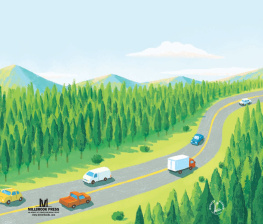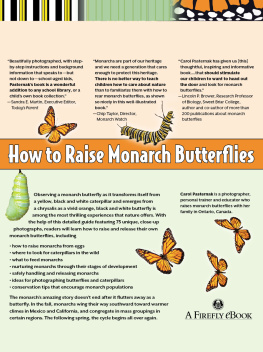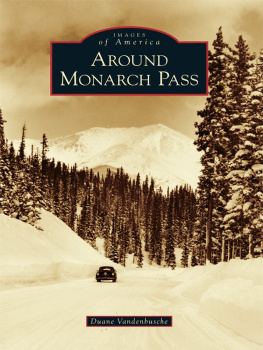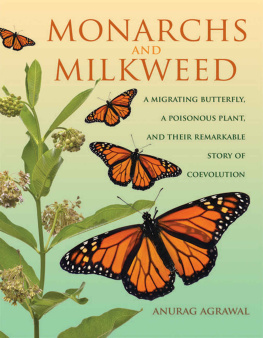Table of Contents
Guide
Page List
For
centuries,
up
and
down
North
America,
every
year
brou
ght
a
mystery.
Monarch butterflies swooped in for a spell, like
clockwork, from somewhere beyondthen
disappeared as curiously as they came.
Where
do
they
go?
People pondered from southern Canada...
... through the middle of the United States
... and all the way to central Mexico.
In 1976, the world finally learned the answer...
with a groundbreaking discovery.
A one-of-a-kind insect journey.
A remote roosting place.
A small speck on the map
where millions of monarchs are drawn like magnets each winter.
The
Great
Monarch
Migration,
the news stories called it.
So, who solved this age-old mystery?
Who tracked these winged wonders from
one end of the continent to the other?
Who found their secret roosting place,
a marvel of nature?
Was
it
Fred,
the
Canadian
scientist,
who spent 30 years studying
the monarch mystery from his
university lab,
who drove through the United States with
Norah, his research-partner wife, like
detectives, trying to track the cagey creatures
migration from Canada southward,
who tagged monarchs fragile wingsfirst with paint
that faded, then with labels that plopped to the ground
when wetand finally with price tags that stuck?
Was
it
Norah,
master
organizer
of
the
monarch
material
they
collected,
who placed ads in newspapers near and far, seeking ordinary
people to help by tagging monarch wings in their hometowns,
who wrote newsletters and kept in
touch with all those volunteers,
who logged and mapped every tidbit
of information they sent in to the lab?
Was
it
those
dozens
(then
hundr
eds,
then
thousands)
of
science
teachers,
back
yard
gardeners,
and
other
curious
souls
who answered Norahs ads
and became citizen scientists,
who gently caught, tagged, and
released the delicate, dancing insects
to help solve the migration mystery?
Was
it
Ken,
the
American
adventurer,
who spotted Norahs ad in a Mexico City
newspaper while visiting there,
who called her in Canada and
agreed to follow the monarchs
through Mexico, where he didnt
speak the language,
who bumped along winding roads
with his newlywed wife, Catalina,
for nearly two years, trying to track
the butterflies twisting trail?
Was
it
the
villagers
and
farmers
of
central
Mexico,
who directed the couple to look
higher, higherup into the thin air
of the volcanic mountains and their
oyamel tree groves,
who for generations welcomed the
monarchs as soaring spirits during
autumn Da de los Muertos celebrations,
who held the whispered whereabouts
of their winter roosting place?
Was
it
Cata
lina,
born
and
raised
in
Mexico,
who
in
tro
duced
Ken
to
her
beloved
monarchs,
who spoke with the locals in her
Spanish dialect to guide their search,
who kept 40 notebooks of meticulous monarch data,
who first crunched through early-morning snow, high in the
Sierra Madre mountains, into an oyamel grove, and exclaimed...
I see them! I see them! Up here!?
Was
it
Jim,
the
Ame
rican
science
teach
er,
who, with his students, attached
teeny tags to tiny wings,
who caught and tagged the very monarch
in a Minnesota goldenrod field that Fred
later found among millions in a Mexican
oyamel grove,
who gave Fred the proof he neededthat one teeny tagto
announce the discovery of The Great Monarch Migration?
YES. THE ANSWER IS YES.
All of themthe scientists, the citizen scientists, the regular
folks along the wayplayed a part in this discovery.
Each person, in small ways or large, helped
answer that centuries-old question:
WHERE DO THEY GO?
And now we know...
Each year, millions of monarchs fly the same path
generation after generation
from southern Canada, through the United States,
to roost for the winter in central Mexicos mountains.
Then they journey north again
feasting on milkweed plants all along the way.
However...
Today, theres a new burning monarch
question to be answered:
How
will
they
survive
?
Monarchs numbers have plummeted since the 1976
discovery. From at least a billion down to millions
a handful now to each hundred then.
Chemical sprays destroy their milkweed plants.
Logging and farming threaten their oyamel groves.
Pollution disrupts the air and weather for their flights.
So, who can make a difference for the monarchs today?
Who can preserve their landing spots and airstreams?
Who can keep them alive?
The
answer
is
actually
no
my
stery
at
all.
MORE ABOUT the MONARCH MIGRATION DISCOVERY
It was in the August 1976 issue of National Geographic magazine that Dr. Fred Urquhart revealed his finding of a single monarch butterfly in Michoacn, Mexico, that marked a discovery. Citizen scientists Ken Brugger and Catalina Aguado Brugger had led Fred and Norah Urquhart into that oyamel grove, a year after the younger couple found the overwintering site with the Urquharts guidance. A tree branch heavy with monarchs snapped and fell right in front of Fred, who then spotted that tagged monarch among millions of flapping wings. It turned out that the tag had been affixed to that monarch wing by high school science teacher Jim Gilbert, and two of his students, in Minnesota.
That single monarch provided the proof that Fred and Norah had sought for over three decades, proof of the monarch butterflies cross-continental, multi-generation migrationone of the longest insect migrations on Earth. Without each persons individual contributionsfrom Catalinas Spanish and Kens drive, to the Mexican locals long-held knowledge, to the thousands of citizen scientists tagging effortsthe remarkable route of The Great Monarch Migration might still be a mystery to the wider world. Its also important to note that history depends on who tells the storyMexican poet and environmentalist Homero Aridjis asks: Did the white scientists really discover the wintering sites that people in Southern Mexico knew about for centuries? What do you think?
Plenty of mystery continues to surround these delicate but durable insects. Scientists across the continent still study the unpredictable, fluctuating numbers of monarchs migrating each yearin the Great Migration from Canada to Mexico as well as in shorter migrations on the U.S. east and west coasts. Researchers continue to learn more about just how these brilliant bugs make their epic trek.













